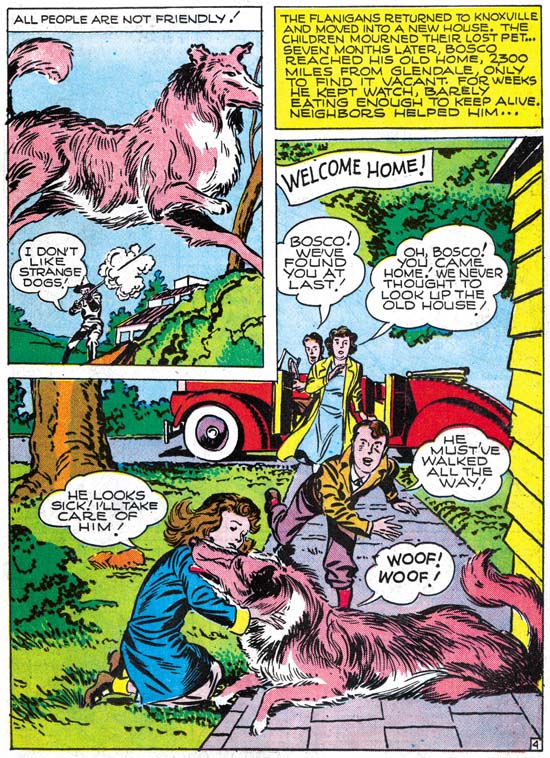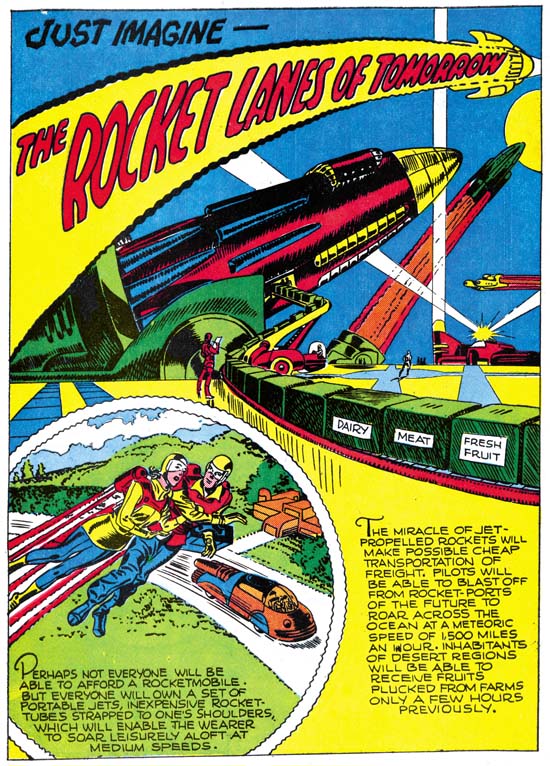Jack Kirby was released from military service earlier then Joe Simon. Jack returned to providing work for DC features such as Sandman and the Newsboy Legion. I do not know the date for Jack’s release from service but the comics provide some clues. Simon and Kirby had previously worked hard to provide DC with material to use while they were away. However it was not quite sufficient and other artists would be used to continue their features. This is most clearly seen in the covers for Adventure Comics. Adventure #98 (June 1945) and #99 (August) have covers that are clearly not by Jack while Adventure #100 (October) has a Kirby cover. Covers can be created with little delay especially by an artist like Jack, but stories require a script (even if Kirby would often pretty much redo it). The earliest post-war Kirby DC stories to appear were in Adventure #102 and Star Spangled #53 (both February 1946). That suggests that there was a gap of a few months where Jack was not getting much income other then whatever royalties that DC was providing.

Picture News #1 (January 1946) “You Can’t Loose A Faithful Dog” page 4, art by Jack Kirby
The desire to produce some extra income may explain why Kirby’s earliest post-war interior art was provided for Lafayette Street Corporation’s comic Picture News. It is a short four page story about a dog that escapes while being transported to his owners’ new home and then travels 2300 miles back to their previous house. It is not much of a story. It starts with a two thirds of a page splash, but that is just a map showing the distance the dog traveled and does not offer much as a showcase for Jack’s talent. The next two pages use four panels to a page. This was a format that Jack had used for a time at the very start of his comic book career but had later largely abandoned for first eight and then later six panel pages. During that time Kirby might revert to four panels when he wanted provide more details. Sadly that is not the case for this story where often the art looks like it could have worked just as well in smaller panels. The best page is the last where Jack provides a splash like ending. The story is such that it seems Jack adhered closely to someone else’s script. Perhaps without Joe around he did not feel confident enough to modify it. Or perhaps Kirby just could not see what could be done to improve it while remaining faithful to the true story that it was supposed to be based on. Kirby inked the art himself and normally that should have assured superior results. The inking style is a simplified version as that previously used at DC. As such it could be called a Proto-Severe Style. For example note how in the final splash-like panel the boy’s clothing folds have the simple form typically found in Kirby’s Severe Style. However also see how the spotting on the little girl’s dress which is more similar to that from S&K’s DC period. Despite the fact that the art is all by Jack, neither the drawing nor the inking truly rescues this piece. “You Can’t Loose a Faithful Dog” may have an historical interest as an example of Jack without Joe, but it is otherwise a rare example of an all too forgettable work by Kirby. Even a genius does not always produce great art.

Real Fact #1 (March 1946) art by Jack Kirby (parachutist and Jean Laffite)
Although I believe that the story in Picture News #1 was done by Jack before Joe had returned, I doubt if that was true with Real Fact #1 (for DC). Stuntman #1 would come out just one month later and Joe was certainly involved with that. The need to recuperate financially after his military service probably explains Jack’s involvement in Real Fact as well. For the cover Jack did the parachutist and the image of Jean Laffite, the other images was by other artists. It may not be a masterpiece, but the simple figure of the airborne forest ranger is surprisingly effective. Not much action but Jack portrays the moment before the jumper pulls his release pin and just the thought of the soon to be billowing parachute adds a little bit of excitement. The inking is Jack’s as well in a style similar to earlier DC works. Here Kirby’s spotting does succeed in adding to the image’s impact; Jack did a beautiful inking job.

Real Fact #1 (March 1946) “The Rocket Lanes Of Tomorrow”, art by Jack Kirby
I wonder if the original readers of this comic appreciated the irony of a piece like “The Rocket Lanes of Tomorrow” appearing in a book called Real Fact? Still it provided an opportunity for Kirby to return to the realm of science fiction. Unfortunately it is not very exciting stuff, but perhaps I am just comparing it with the fantastic machines that Jack created much later. Judging largely by the cloth folds of the flying couple, the inking appears to be Jack’s. The next page has some men in space suits inked in a manner very similar to how Kirby handled similar costumes at the start of his comic book career.

Real Fact #1 (March 1946) “Pirate Or Patriot?”, art by Jack Kirby
At this point readers maybe wondering what happen to Jack, the works presented so far in this post just do not seem to have the typical Kirby impact. Well “Pirate or Patriot?” shows that Kirby had not lost his touch. Although a short four pages, this story provides the type of excitement that would appear in Simon and Kirby’s crime comics a year later. No qualifications about Kirby’s art here, it is all first rate stuff. Look at that splash panel, the composition was exciting enough when it was used for the cover of Daring Mystery #8 (January 1942) but Kirby has improved upon it. By providing a low viewpoint, so low that all the feet are at eye level, the advancing force seems more heroic. The perspective also allows the figure of Jack Laffite to be larger then his companions without seeming unnatural. Jack inked the piece himself and he did a superb job. Some of the clothing folds have the simple forms that would later appear in the Severe Style. Another page provides an early appearance of an abstract arch (see Inking Glossary for an explanation for inking terms used here). There are no signs yet of picket fence crosshatching or drop strings. For the most part the spotting is closest to what is found in prior works for DC. I doubt that we will ever see a DC Archive for Real Fact Comics, but “Pirate or Patriot?” certainly deserves to be rescued from obscurity.
Simon and Kirby would do a couple of other pieces for Real Fact Comics which I will discuss next week.


Hi Harry,
Looks like Kirby Kolor to me! 😉
Stan
“Rocket Lanes of Tomorrow” was reprinted in New Gods #6 and “Pirate or Patriot?” in Mister Miracle #4, both in 1971. That may have been the only reprint appearance of the Jean Laffite story…but “Rocket Lanes” has been reprinted by DC three or four other times over the years, most recently in the 1999 trade paperback collection Mystery In Space.
RAB,
I’m really glad to hear that “Pirate or Patriot” got reprinted once. At least Mister Miracle comics are easier to find then Real Fact #1.
Stan,
How could I have missed it?
Harry